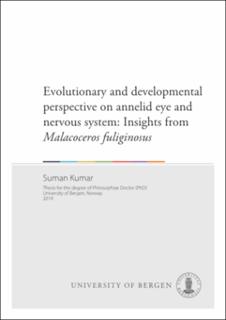| dc.contributor.author | Kumar, Suman | |
| dc.date.accessioned | 2019-12-17T11:10:42Z | |
| dc.date.available | 2019-12-17T11:10:42Z | |
| dc.date.issued | 2019-11-25 | |
| dc.date.submitted | 2019-11-12T11:12:28.335Z | |
| dc.identifier | container/62/19/3b/d6/62193bd6-1a19-4893-bd9b-1b89b046bce5 | |
| dc.identifier.uri | http://hdl.handle.net/1956/21152 | |
| dc.description.abstract | Eye evolution is far from resolved and despite the considerable interest and decades of study, many questions remain on the evolutionary scenarios of eyes and photoreceptor cells. While examining their ultrastructure has been an important way for comparative studies, the high degree of variation of eye structures/complexities within species (and closely related species) calls for more detailed studies at the molecular level. As with many lophotrochozoan taxa, annelids also display simple to elaborate eye structures. Although general homology of the cerebral rhabdomeric eyes is assumed, this has not been firmly established leaving the scene in the annelid ancestor unanswered. To gain an understanding of the situation in a long pelagic annelid larva, we studied Malacoceros fuliginosus. The larvae possess multiple eyespots and therefore suitable for studies on how different eyespots develop and integrate into the nervous system. We used ultrastructure and gene expression studies to understand the eyespot structure and development. Our phylogenetic analysis of annelid r-opsins revealed the existence of two r-opsin paralogs - r-opsin1 and r-opsin3 within the two main annelid groups - sedentaria and errantia, whereas in basal branching annelids only a single r-opsin type is present. In comparison with the well-studied annelid Platynereis dumerilii, we find that the rhabdomeric eyes have several similarities in terms of spatial and temporal development, r-opsin expression dynamics and axonal connectivity. This suggests homology of the two rhabdomeric eyes and the more complex dorsal eyes in P. dumerilii is likely a case of augmentation of a simple eyespot. Apart from visual r-opsins, the eye PRCs in M. fuliginosus also expresses the newly classified opsin type, xenopsin. Inspection of the eye structure also revealed the existence of a prominent cilium in both rhabdomeric eyes. Additionally, we also identified a c-opsin in an extraocular cell type thereby making it the only species so far having both c-opsin and xenopsin. Taken together, our data provide insights into the eye organization of the annelid ancestor and adds information on how eye evolution is shaped by opsin gain and loss. The second topic of interest is the nervous system development in the M. fuliginosus larva. The evolution of the bilaterian nervous system is a topic of long-standing debate inciting the need for studies at multiple levels along with broader species sampling. A major question is whether the centralized nervous system seen across taxa is derived from a common ancestor or independently originated multiple times. Characterization of the nervous system has been mainly done at the level of gene expression patterns along the major body axes, anterior-posterior and dorsal-ventral. One aspect that has been overlooked particularly in lophotrochozoans is the development of pioneer neurons that give rise to the early neuronal scaffold. In M. fuliginosus, we identify at least three pioneer neurons that are responsible to form the complete early neuronal scaffold. While a posterior neuron pioneers the path for the ventral nerve cord, pair of neurons form the prototroch ring nerve and a ganglion cell near the apical organ with descending axons prefigures the central ganglia. Here we focused on the development of the posterior pioneer neuron and distinguish it from the rest of the neurons. It is one of the earliest cells to differentiate along with other ciliated cells of apical tuft and prototroch cells which are known to have mosaic development. The posterior neuron does not express the well-characterized proneural genes such as Ascl1, Olig, NeuroD, and Ngn and moreover, they even lack Prox1 and Elav which are represented by most other neurons. From a molecular perspective, the posterior pioneer neuron is indeed distinct from the rest of the neurons and may develop in a cell-autonomous manner. | en_US |
| dc.language.iso | eng | eng |
| dc.publisher | The University of Bergen | en_US |
| dc.relation.haspart | Paper I. Suman Kumar, Sharat Tumu, Conrad Helm, Harald Hausen. (2019): The neuron pioneering the ventral nerve cord does not follow the common path of neurogenesis in the polychaete Malacoceros fuliginosus. The article is not available in BORA. | en_US |
| dc.relation.haspart | Paper II. Suman Kumar, Harald Hausen: Development and molecular characteristics of cerebral eyes in the sedentary polychaete Malacoceros fuliginosus – Insights into annelid eye evolution. The article is not available in BORA. | en_US |
| dc.relation.haspart | Paper III. Clemens C. Döring*, Suman Kumar*, Sharat Tumu, Ioannis Kourtesis, Harald Hausen: Xenopsin in eyes of larval bryozoans and annelids. *Equal contribution. The article is not available in BORA. | en_US |
| dc.rights | In copyright | eng |
| dc.rights.uri | http://rightsstatements.org/page/InC/1.0/ | eng |
| dc.title | Evolutionary and developmental perspective on annelid eye and nervous system: Insights from Malacoceros fuliginosus | en_US |
| dc.type | Doctoral thesis | |
| dc.date.updated | 2019-11-12T11:12:28.335Z | |
| dc.rights.holder | Copyright the Author. All rights reserved | en_US |
| dc.contributor.orcid | 0000-0002-2280-9113 | |
| dc.identifier.cristin | 1757386 | |
| fs.unitcode | 12-32-0 | |
